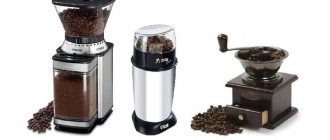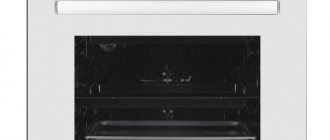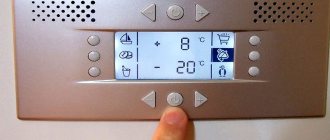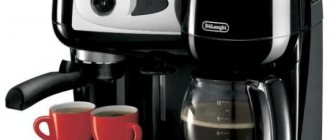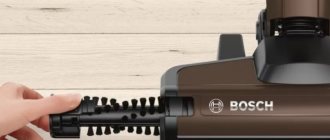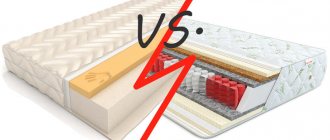How to choose a vacuum cleaner for an apartment: what to look for
A vacuum cleaner is a complex household device; its choice should be based on technical characteristics, and not on design and price. The emphasis should be on:
- Power, the higher it is, the more you will have to pay for electrical energy. Depending on the design and manufacturer, the cleaning equipment motor can consume from 1200 to 2500 W.
- Suction power (from 250 to 550 W) or an indicator of the cleaning capabilities of the vacuum cleaner. This should not be confused with the first parameter.
- Filter type. A HEPA filter is considered a progressive development, suitable for dry cleaning of rooms where allergy sufferers live.
Secondary characteristics include: cable length, weight, noise levels, dust container volume. Pay attention to the warranty period and the availability of service centers in the city. Don’t forget about the equipment: the number of brushes, additional cleaning accessories.
When planning to buy a vacuum cleaner for your apartment, you first need to determine what type of cleaning is needed: dry or wet. It is better to purchase a washing model that will allow you to clean not only smooth surfaces (linoleum, laminate, parquet), but also carpets.
Note! Before purchasing, check the length of the cable; if it is too short, you will have to constantly plug it into a new outlet.
For a small apartment, a traditional vacuum cleaner with a standard set of attachments will be sufficient: for crevices, cleaning furniture, and for cleaning floors and carpets.
How does suction power differ from the power consumption of a vacuum cleaner?
It is necessary to distinguish between the power of the electric motor of the vacuum cleaner, which is consumed during operation, and the suction power.
The latter determines the quality of cleaning, how quickly and strongly the garbage is pulled inside. Power consumption means current consumption, energy per hour. It is often indicated on the body of the model in thousands of watts. Note !
The more power the vacuum cleaner consumes, the more you will have to pay for electricity. There is no direct connection between the power of the vacuum cleaner engine and the “draft” of air, since it is also influenced by other factors.
Types of structures
Types of vacuum cleaners according to the type of design can be divided into 5 varieties. Built-in models are not installed in apartments and have a number of disadvantages:
- expensive;
- require regular maintenance;
- you will have to lay pipelines under the floor, walls or ceiling.
These are centralized systems, with a power unit that takes up a lot of space.
Classic version
The model has a horizontal body with a waste collection compartment and a motor part. The cleaning equipment has wheels and a flexible hose and a collection pipe. The kit comes with several attachments. They work from the electrical network.
Rating of the most reliable traditional vacuum cleaner models:
| Model | Weight, kg | Dust container volume, l | Additional characteristics of vacuum cleaners |
| Philips FC8294 PowerGo | 4,3 | 3 | Super Clean Air filter, catching up to 99% of harmful particles, long cord - 6 m |
| Bosch BSGL3MULT1 | 5,7 | 4 | has a dust bin full indicator, automatic cable rewind |
| Samsung SC4140 | 3,7 | 3 | has a dust bin full indicator, HEPA filter, suction power 320 W |
| Scarlett SC-VC80B95 | 2,9 | 2,5 | HEPA filter, parked vertically and horizontally |
Vertical option
Designed for cleaning smooth surfaces. The dust collector is integrated into the tube. Visually, the vacuum cleaner resembles a mop, but for cleaning you will need to adhere to the desired angle of inclination.
Upright vacuum cleaners with a steam generator are not suitable for cleaning carpets and piles.
Review of inexpensive vertical, corded models for wet and dry cleaning:
| Model | Weight, kg | Dust container volume, l | Noise level, dB | Description of additional functions |
| Bissell 17132 (Crosswave) | 5,2 | 0,62 | 80 | aquafilter, designed for cleaning large areas |
| Kitfort KT-535 | 5,3 | 1 | 80 | 3 cleaning levels, extended handle and vertical parking function |
| Tefal VP7545RH | 5,5 | 0,80 | 84 | independent operation of the steam cleaner and vacuum cleaner |
Manual models
Suitable for cleaning vehicle interiors and upholstered furniture, they are compact in size. They are light and mobile. Clean vertical surfaces.
| Model | Battery capacity, mAh | Dust container volume, l | Dimensions, LxWxH, mm | Additional benefits |
| Philips FC6142 | 1 800 | 0,5 | 460x160x160 | flat charging base, collects liquid |
| Bosch BHN 20110 | 1 500 | 0,3 | 368x138x110 | cyclone filter, battery charge indicator |
| Xiaomi CleanFly Portable | 2 000 | 0,1 | 298x70x70 | aquafilter and container |
| Clatronic AKS 828 | 1 400 | 0,5 | 380x130x110 | collects liquid |
Vacuum cleaners are not suitable for cleaning the house. They operate from a cigarette lighter or battery, so they discharge quickly.
Robotic models
Vacuum cleaners independently carry out cleaning according to a preset program. These are compact units that penetrate hard-to-reach places.
Robot vacuum cleaners can work according to a schedule and need to be recharged.
Review of the best models in the mid-price segment:
| Model | Dry/wet cleaning | Working time, hour | Remote control | Minuses |
| iRobot Braava 390T | +/+ | 4 | — | do not clean carpets |
| Xiaomi Mi Robot Vacuum Cleaner | +/+ | 2,5 | + and has Wi-Fi | Doesn't clean high pile carpets well |
| Panda X500 Pet Series | +/+ | 1,5 | — | short-lived battery |
| Philips FC 8776 | +/- | 2 | + | does not clean high-pile carpets, does not cope well with debris in corners |
What should be the suction power of a vacuum cleaner?
The power of a home vacuum cleaner is an indicator of functionality. For cleaning equipment, this indicator has two meanings:
- Power consumption of electrical energy. To save electrical energy, the indicator should be minimal.
- Vacuum cleaner suction power. The indicators of this parameter are less than the previous one and range from 250 to 550 watts. The higher it is, the better the cleaning.
Attention! To clean surfaces with different structures, the suction power of the vacuum cleaner must be adjustable.
Power consumption
The power of a vacuum cleaner for a home, which shows how much electrical energy it spends per unit of time, is called consumed. The established indicator also indicates the electrical load on the network.
The power consumption of a home vacuum cleaner is marked with large numbers on its body. This is done to impress clients. There is no direct connection between power consumption and performance. It should be taken into account that if the units have equal suction power, and one vacuum cleaner consumes 3000 W and the other 1500 W, then this only indicates that the first one will be less economical in terms of energy consumption. Therefore, when purchasing a unit, you should give preference to the one whose power consumption is lower. In this case, less electricity will be consumed.
Which dust collector to choose
The type of filtration determines the degree of purification of the air that comes out of the vacuum cleaner during its operation. A proper vacuum cleaner should not generate dust.
There are 3 types of dust collectors.
Bags
The most common option for collecting dust and debris. There are 2 types of dust collectors: disposable (cellulose) or reusable (cloth, textile). The first option is hygienic, it holds dust better, down to 3 microns. The second option is more practical, but does not hold dust and debris well. Fabric dust collectors can harbor dust mites and harbor bacteria.
European manufacturers install bags in the body, American manufacturers install bags in the handle.
Container
This category includes cyclone and bagless vacuum cleaners. A plastic container acts as a trash bag.
Cyclone models work on the principle of twisting a spiral. Garbage is sucked in along a spiral path and settles evenly in the container, without complicating the operation of the equipment. Vacuum cleaners with a cyclone filter are characterized by increased noise levels and high cost.
Aquafilter
The operating principle is based on purifying recycled air in a water tank. Additionally, the vacuum cleaner can have a HEPA filter.
These models require careful care as they are prone to mold. Recommended for allergy sufferers.
- hookah bars;
- separator
The first type of filter copes with large dust particles, but it will be difficult to remove small ones. Therefore, vacuum cleaners in this series have additional fine filters, which must be washed and changed regularly.
The separator filter works like a centrifuge. Thanks to this effect, wet dust settles in the flask rather than coming out with the air.
This type of filter provides maximum protection against the release of fine dust back into the air. Modern vacuum cleaners with HEPA are recommended for allergy sufferers.
You can tell that it’s time to change the filter by the unpleasant smell during cleaning. Manufacturers produce paper and reusable filters. The latter can be washed under strong pressure of cold water.
Best type of cleaning: dry or wet
In addition to power and filter, in order to know which vacuum cleaner is best to choose for your home, you need to decide on the type of cleaning.
Dry cleaning is carried out using vacuum cleaners:
- Bag dust collector. All dirt remains in the bag, which is replaced or cleaned as it fills. Disposable dust bags are hygienic, but you have to keep buying them and they may break.
- Container dust collectors. Garbage and dust accumulate in a transparent container, which is emptied and washed as it is filled.
- Aquafilter or water container. The dust in such a vacuum cleaner settles in a container of water. To catch the smallest debris, an additional fine filter can be installed. The suction characteristics of cleaning equipment do not decrease as the container is filled.
How to choose a vacuum cleaner
A vacuum cleaner is one of the oldest household appliances: for more than a hundred years, these electric assistants have been helping us keep our homes clean, while simultaneously terrifying our pets. Only modern models are lighter, more convenient, more environmentally friendly, and some can even vacuum cleaner on their own. It is hardly possible to find a family that does not have a vacuum cleaner, and this is not surprising - it is truly indispensable when cleaning. This guide will tell you how not to get lost in all the variety of modern vacuum cleaners.
Regular, vertical, construction or robot?
The classic vacuum cleaner has not undergone many changes over the past decades - the same body with a pump and filter, a flexible hose and nozzle. However, before buying a regular vacuum cleaner with a classic layout, be sure to pay attention to other types of vacuum cleaners - maybe they will suit you better.
The vertical vacuum cleaner is not a new product at all (it is also more than a hundred years old), it’s just that it has not been widespread in Russia for a long time. And even now its popularity is low, which is not due to habit, but to quite serious shortcomings:
- small volume of dust collector;
- low power and performance;
- you cannot “crawl” the attachment under a sofa or closet;
- more load on the arms due to the greater weight of the barbell;
- Not every model will be able to vacuum walls or ceilings.
But vertical vacuum cleaners take up very little space, which makes them very convenient in small apartments - especially since in small areas the main disadvantages of these models are not so noticeable.
And we can’t help but mention cordless vertical vacuum cleaners, which are gaining more and more popularity. Although most of the shortcomings of the form factor remain in them, they are all leveled out by the absence of tangled wires.
A construction vacuum cleaner is designed for cleaning serious contaminants - cement dust, sawdust, dirt, puddles, etc. An ordinary vacuum cleaner cannot handle this - special solutions are needed to protect the engine and parts of the vacuum cleaner from heavy and sharp fragments and construction dust.
Robot vacuum cleaners are all the rage these days. Of course: after all, they do all the work of cleaning the house themselves. True, it also has its own subtleties: the “robots” take a long time to clean, and they often tend to get stuck under the bed or get tangled in wires. But there is no doubt now that the future belongs to them. Moreover, their prices are constantly falling.
If you are still sure that you need a regular vacuum cleaner, it’s time to decide what they are, how they differ, and what characteristics are most important to you.
Characteristics of vacuum cleaners
The operating principle of a conventional vacuum cleaner has not undergone any changes in a hundred years. An electric air pump creates a vacuum at the inlet of the nozzle connected to the device with a flexible hose. The air sucked in by the nozzle carries away dust particles, then the air is cleaned and comes out again, and the dust remains inside the vacuum cleaner.
A conventional vacuum cleaner performs dry cleaning, i.e. collects dry debris particles. It cannot cope with contaminated surfaces - only wet cleaning with an ordinary floor cloth or a washing vacuum cleaner will help.
A washing vacuum cleaner sprays water under the suction nozzle (often with detergent to increase efficiency) and then collects it from the surface along with dirt. The cleaning efficiency of such a vacuum cleaner is much higher. If you have to wash your floors often and a lot, a washing vacuum cleaner can become an indispensable assistant for you. However, it also has disadvantages:
- it is much more expensive than usual;
- it is much heavier and larger - the weight of the water in the device’s containers is added to the weight of the vacuum cleaner itself;
- servicing a washing vacuum cleaner and preparing it for work is more difficult and takes more time.
Some owners of washing vacuum cleaners are quickly disappointed in their purchase - sometimes it’s easier to quickly wipe the floor with a regular mop than to bother with assembling, filling with water and cleaning the washing vacuum cleaner.
Handheld vacuum cleaners, as the name suggests, are used “on the fly”. As a rule, these are low-power models designed for collecting dust and crumbs from car interiors, furniture, window sills, interior items, and other horizontal surfaces. Such models are often rechargeable, which makes them easier to work with. Of course, they are not intended for cleaning the floor.
Many cordless upright vacuum cleaners have rods that can be removed, turning them into a manual model. This vacuum cleaner can vacuum both shelves and floors.
Suction power
The efficiency of a vacuum cleaner depends on two parameters. Firstly, it depends on the size of the air flow - the larger it is, the heavier particles the nozzle can suck in. Secondly, from the vacuum created by the pump - the greater it is, the less the flow will drop on various obstacles (brush, nozzle, filters, etc.). The product of these quantities is the suction power.
Suction power up to 350 W is suitable for cleaning light dirt from simple smooth surfaces (linoleum, parquet, tiles, etc.). A turbo brush on a vacuum cleaner with such suction power will be ineffective.
Suction power from 350 to 450 W will allow you to clean fluffy materials (carpet, carpet, etc.) and cope with serious dust deposits.
Suction power from 450 W will provide deep cleaning of upholstered furniture and long-pile coverings. In addition, a vacuum cleaner with such power can significantly increase cleaning performance due to its wide nozzles.
High power is not always good: some materials require delicate handling, so a power regulator is desirable on such vacuum cleaners.
But you can’t choose a vacuum cleaner based on only one characteristic, because there is no single way to measure suction power. In addition, it may decrease depending on the nozzle you use, or when the container is filled with dust, and this varies from model to model.
Manufacturers also go to various lengths to indicate the maximum possible suction power for their model. For example, measure this characteristic with the fine filter removed, which seems to be optional. As if - because the vacuum cleaner is still sold and used with this filter, but removing it from the standard configuration for the test allows you to specify much greater suction power.
In order not to be disappointed in the vacuum cleaner, when choosing, pay attention to power consumption. When choosing between two vacuum cleaners with the same suction power, it is better to choose the one with more power consumption - it is more likely to provide high cleaning efficiency. However, that's not all.
The power consumed by the vacuum cleaner engine is an unambiguous and constant characteristic. The more powerful the engine, the higher the suction power will be, but only with the same design! The type of dust collector and filter design can greatly influence the efficiency of the vacuum cleaner, so before purchasing, you should compare these characteristics of the selected models.
The more powerful the engine, the higher the suction power will be, but only with the same design.
Dust container type
Passing air containing dust through a bag is the oldest, but still the most effective method of collecting garbage. All other parameters being equal, the efficiency of vacuum cleaners with a bag is higher, but this type of dust collector also has disadvantages:
- The reusable dust bag will need to be shaken out and cleaned periodically. The activity is not only unpleasant, but also harmful if you do not take care of respiratory protection.
- disposable dust collectors will appeal to “clean people”, but they will have to be purchased, and each cleaning will be associated with some monetary costs, and not so inconspicuous - the price of a disposable bag ranges from 100 to 1,000 rubles.
- bags for your model may not be on sale and then it will become impossible to use the vacuum cleaner even if it is in full working order. And you shouldn’t hope that a reusable bag will save you from this misfortune - it, too, will one day wear out and require replacement.
What determines the “power” characteristics of a vacuum cleaner?
Suction power can be maximum and medium effective. The difference between them is easy to understand.
The maximum parameter declared by the manufacturer is observed in the first seconds of operation of the vacuum cleaner, at the moment after turning on the device under conditions close to experimental ones. Then it decreases, and therefore it makes no sense to take into account the suction level immediately after startup.
The average useful power of the vacuum cleaner, set in watts, determines the suction during use. It is less than the maximum, as established and confirmed, by a third. At the same time, it may drop to lower levels.
Factors that influence the “power” characteristics of the vacuum cleaner should be taken into account. There are several of them.
Build quality
The parts of the apparatus must fit tightly to each other, be firmly fixed, and have a stable position. Otherwise, air drawn in from outside will affect the suction result. We are also talking about the functional parts themselves, assemblies, and their properties. Reputable manufacturers also equip vacuum cleaners with specially designed accessories. After all, the dimensions of the hoses, weight, shape and area of the nozzles play no less a role. The use of lightweight options and new materials improves suction power.
Design features
The internal structure of the equipment affects the suction power, even if it consumes the same amount of energy.
Pay attention to the type of dust collector. It determines how much air enters the tube. Cyclone-type models have the best characteristics. A bag or aquafilter results in the air flow having to overcome additional resistance or another obstacle in the form of a water tank. As the amount of debris in the dust container increases, the suction power decreases. If 70% of the dust collector space is already covered with debris, the draft weakens or disappears altogether. Many manufactured vacuum cleaners are equipped with an indicator on the dashboard that indicates how full it is. If there is no such sign, you must remember to look inside.
It's easier if the dust collector is made of paper. It requires a simple replacement with a new one. The reusable fabric bag is shaken out, and then washed without adding detergents and dried. The bag is ready for installation in the vacuum cleaner. Dry cleaning the bag without washing it risks leaving the remaining dust clogging the interior.
If the suction drops, the integrity of the bag should be checked. This problem also cannot be ignored.
Choices
If you need an inexpensive vacuum cleaner to maintain an acceptable level of cleanliness in a small apartment, choose from inexpensive bagless models.
A handheld vacuum cleaner will make it easier to remove dust from furniture and interior items. And if it is rechargeable or works from a cigarette lighter, then it will not be superfluous in the car.
A vacuum cleaner with an aqua filter is suitable for allergy sufferers, asthmatics and other people who cannot tolerate dust. In addition to cleaning, such a vacuum cleaner will additionally humidify the air.
If you are annoyed by the sound of a vacuum cleaner, or you do not want to disturb your neighbors, household members and pets, choose among low-noise models.
Washing vacuum cleaners are suitable for those who do not like to spend a lot of time cleaning, because you vacuum and wash the floor at once.
Source
What should be the suction power of a vacuum cleaner?
When choosing a vacuum cleaner, buyers pay attention to the manufacturer, appearance, size of wheels so that the equipment is mobile and maneuverable, length of the power cord, equipment and other little things. But the ability of a product to efficiently absorb dust and debris is rarely of interest to anyone, since many are sure that this depends on the power consumption.
What suction power should a good vacuum cleaner have, what does it depend on, what affects its quality - you will find the answers to these and many other questions by carefully reading our article.
What should be the suction power of a household vacuum cleaner?
This type of vacuum cleaner is divided into industrial and household tools. It’s clear which vacuum cleaner has the highest suction power. Signs of the economic model are miniature size and network energy consumption of up to 2 kW. Production models are designed for three-phase connection and consume 5-7 kW. A common characteristic of all household vacuum cleaners is the use of energy with high efficiency. For this type of tool, the suction power indicator is determined as a derivative of the vacuum force and air flow. Which tool is the most powerful depends on the productivity of collecting heavy contaminants in cubes per unit of time.
For construction vacuum cleaners, the suction value is adjustable in the range of 17-250 bar. For comparison, household models require 150-170 bar. It is this indicator that determines the size and severity of the particle that can be taken with a sucker.
The air capacity should be 60-100 l/sec. On average, the suction power of small construction vacuum cleaners is 200-260 W. The developers of the Karcher company have achieved the best power/suction power ratio.
All developers of vacuum systems are fighting for the economical use of energy in a vacuum cleaner. By European standards, a high network capacity is bad manners.
Types of power
Some users have never thought about the fact that vacuum cleaners have two types of power, and the consumed parameter turns out to be not the main thing in the characteristics of modern household appliances designed to remove dust from rooms.
Power consumption
This parameter varies between 1500-3000 W, and many users believe that a powerful vacuum cleaner should have the highest similar performance, but this is not the case. This parameter indicates how much load this model puts on the home electrical network during operation, but there is no direct relationship between power consumption and the efficiency of the product.
Experts explain this by saying that the quality of operation of a home unit is influenced by many other factors, so two vacuum cleaners with equal power consumption will not produce identical and effective cleaning work. This parameter is always several times higher than the same suction characteristic, which is why all manufacturers indicate it in advertising their products.
During operation, it turns out that the lower the power consumption, the more economical the product and the less consumers will have to pay for the consumption of electrical energy. Therefore, for those who are going to frequently use a household unit to clean large rooms, it is better to purchase a small vacuum cleaner with average power consumption. If you plan to use such equipment no more than once a week to clean an average city apartment, then more power will not harm you.
Suction power
Its indicator is within the following limits: 250-480 W, a simple principle applies here: the more intensely the air is sucked in, the better the dust is removed. Based on suction power, modern household appliances can be divided into two types:
- for small rooms, a power of 250-320 W will be sufficient;
- with heavy dust and a large area - 350-500 W.
It should be taken into account that with constant operation at maximum power, the maximum service life of the product quickly decreases.
For allergy sufferers, for whom the quality of cleaning is very important, experts recommend a super-powerful vacuum cleaner with a cyclone filter and a HEPO 13 fine filter element, which traps all types of allergens. But you must be prepared for the fact that such equipment quickly wears out carpets, because it works at maximum speed without loss of suction power.
Characteristics of vacuum cleaners by suction power
It remains to understand what the parameters we found mean.
Types of suction power
There are two types of vacuum cleaner power: medium efficiency (250-300 W) and maximum efficiency (no more than 480 W). To find the one you need, let's look at their meaning.
With average efficiency, the device cleans evenly. The device reaches its maximum value only at the beginning of operation, because it is valid only in ideal conditions (an empty dust collector). The average effective indicator is one third less than the maximum.
A vacuum cleaner wears out faster with high power, and there is a possibility that the quality of upholstery, carpets and other surfaces will quickly deteriorate.
Suction power control on devices
Manufacturers offer devices in which the suction power varies. The user is able to control the power of the vacuum cleaner, which has a special function for adjusting this parameter.
The constant indicator makes cleaning more comfortable and convenient. This results in an economical use of time and effort.
There are 2 types of regulator installation:
- Mechanical. The owner needs to set this value himself.
- Digital. Modern manufacturers install devices on units that are controlled by remote control. With such a device, there is no need to get close to the vacuum cleaner, and this makes the cleaning process much more convenient, because you can adjust the power using the regulator located on the hose of the unit.
Important! The remote control must be removed immediately after wet cleaning, since remote control involves the use of electronic equipment that can be damaged.
This option is not the cheapest. If you manage to find an excellent quality vacuum cleaner that includes all the necessary parameters, then you don’t have to overpay for such an addition.
What does it affect and what does it depend on?
A modern vacuum cleaner is a compact, but not small and at the same time quite complex unit, and its useful power is influenced by numerous factors:
- The engine is the most important among all components; experts call it the heart of the product. Its efficiency is 25-35% of the power consumption, i.e., with the specified parameter of 2 kW, the real suction power will be 500-700 W, respectively - this power is enough to clean any apartment, but there are other nuances that affect this parameter.
- Product types. A water filter, a plastic reservoir or a dust bag affects suction power differently due to its design and filling level.
- Type of filter elements and their quantity. The more complex the filter design, the more it reduces suction power. HEPA devices, due to their fine mesh design, have a fairly strong effect on suction power, especially after long-term use. For example, a vacuum cleaner with two coarse-mesh filters will show better suction results than an analogue with five fine-pored filters, but it will only retain large impurities.
- The build quality of the unit. With the same engine power, a vacuum cleaner that has a good and high-quality assembly with precisely fitted parts will show higher suction power. Therefore, the European assembly is valued by consumers much higher than the Asian or yellow one.
During cleaning, each user selects the optimal power mode of the unit using a special regulator located in the upper part of the product. Experts advise choosing devices with a power that is ideal for your apartment, so as not to overpay for extra kilowatts.
There are two main types of suction power regulators that are used on modern models of vacuum cleaners:
- Mechanical ones, which use a rotary switch to regulate this parameter from minimum to maximum value.
- Digital - adjustment is carried out by the control panel.
The second type is installed on elite class models, which have the highest cost.
As already mentioned, manufacturers do not indicate suction power, limiting themselves only to the same parameter consumed, so when choosing a model, simply divide the indicated power by four: for example, the product says 2.5 kW, which means the suction power will be at least 625 W, and this is quite high rate. Another way to find out this parameter is to look for it in the instruction manual, but even there, not all manufacturers indicate the exact characteristics.
All that remains is to find the required value on the Internet, to do this, insert the exact name of the model you are interested in into a search engine and look for all the information about it on the manufacturer’s website. Why do we pay so much attention to this particular technical characteristic? Because not only the quality of cleaning your premises depends on it, but also how easy this process will be.
What does the created vacuum depend on?
In the characteristics of a vacuum cleaner, manufacturers usually indicate the maximum value of vacuum and air flow during operation. Accordingly, the greatest vacuum is possible at zero air flow, and, conversely, the most air is consumed at the moment when the vacuum is zero.
What kind of vacuum a vacuum cleaner creates depends on the size of the hole through which the air flow is passed. The larger it is, the smaller the value of this quantity.
Industrial vacuum cleaners usually have a high vacuum, the suction power of which is designed for large fractions of debris. It is created using a special vacuum turbine. Most industrial devices are equipped with a special sensor for measuring the level of vacuum created.
Likes for the post!
What should be the suction power?
We have already figured out what factors this value depends on, now let’s see how to use it correctly in everyday life:
- 350 W - this power is quite enough for dry cleaning of surfaces such as linoleum, parquet, and floor tiles. If you do not have carpeting in the form of paths and large carpets with dense pile, and you are not going to clean upholstered furniture, then choose a product with this indicator.
- 400 W - you can clean carpet and upholstered furniture from pet hair.
- 450 W and more will successfully cope with long-pile carpets and upholstered furniture of any density.
It is better to choose equipment with a power regulator in order to clean any surfaces with reduced electrical energy consumption.
Vertical washing devices are armed with 400 W of suction power, because they remove not only dirt, but also moisture from surfaces.
Vacuum cleaner hose length and suction power
The length and design of cleaning accessories also affects the suction power, not least, although for the sake of fairness, we note that it is not decisive. Meanwhile, the length of the hoses, their shape and weight, as well as the size and working surface of the nozzles undoubtedly contribute to the capabilities of the vacuum cleaner. Maybe you haven’t thought about this before, but you need to be no less attentive to the choice of accessories than to the vacuum cleaner itself. And all because often the suction power and, as a result, the quality of the cleaning itself will largely depend on their abilities. Manufacturing companies do not stop researching in this area and are constantly creating new products. Thus, the Thomas company offers special accessories for cleaning parquet and laminate floors; moreover, the model itself indicates the presence of this nozzle in the kit.
The Thomas Twin T2 parquet aquafilter can even be washed, and when it comes to a washing vacuum cleaner, suction power is important especially for those surfaces that do not tolerate excess moisture. And in this case, the capabilities of the vacuum cleaner itself plus the features of the nozzle can give much better results together than separately. And the German manufacturer Pro-Aqua, in order to increase the already high suction power, offered new cone-shaped hoses for its devices, which, thanks to a unique design, added 50 more to the 998 AeroW. At the same time, the electric carpet nozzle enhanced the suction capabilities of the vacuum cleaner with the effect of strong vibration, which also produced striking results. This is how seemingly small finds can become an excellent addition to an already functional and effective device.
Now you know what suction power is best for a vacuum cleaner and what you should pay attention to when choosing a truly powerful and effective cleaning device. From all that has been said, we can conclude that the most important thing in a vacuum cleaner is the absence of filters. If they are not there, you don’t have to use a lot of power consumption, and this will allow you to save twice as much. On the other hand, in addition to the absence of filters, the correct choice of accessories seems very desirable, because the quality of cleaning often depends on them. Moreover, suitable and effective attachments can significantly increase and multiply the cleaning results. We advise you to pay special attention to those models that are equipped with such unusual accessories. They can be very useful for high-quality care of individual surfaces. So, for example, for caring for soft interior items, there is nothing better than the electric brush-beater from the set of separator vacuum cleaners, which is considered a unique feature of such models. And brushes with natural bristles are perfect for caring for delicate interior items. Be attentive and careful and do not lose sight of the details, they can often play a decisive role in any process, including cleaning.
How to choose the right power for yourself
When choosing a new vacuum cleaner in retail, users face certain difficulties: they must take into account many nuances that affect the effective operation of such a complex household product. Many models consume at least 1600 W, and their suction power is 200-480 aeroW (this is a new term borrowed from the English system of measures), which is quite enough to clean a standard city apartment.
Excellent budget options were developed by the German company Thomas - their quality is impressive and the cost is very affordable. Another company from Germany, Zelmer, has found unique ways to compensate for the low suction power of 300 aeroW by adjusting the length of the hose and using nozzles according to the surface being cleaned. As a result, the cleaning efficiency is no worse than that of the most powerful analogues from other manufacturers.
If you have decided in advance for what needs you primarily need a vacuum cleaner, then choosing a model will be much easier. The larger the processing area and the higher the level of contamination, the more powerful the unit should be. But the following principle also applies here: equipment of any power will encounter certain difficulties in cleaning the room for the first time, but with each new cleaning it will be easier to cope with, because before that the cleaning was carried out much better than before with the old equipment.
The high cost of luxury vacuum cleaners is due to the fact that many manufacturers equip the most expensive models with accessories of the highest category and only of excellent quality, both in material and workmanship. Experts advise choosing only manufacturers that have been proven over the years, who are highly popular and well-known in the sales market.
As a rule, such household appliances are equipped with reliable motors with high efficiency and have a very long service life. Therefore, users who are going to use a vacuum cleaner to effectively clean high-pile carpets and have pets in their apartment should choose equipment with a power consumption of at least 2 kW, then the suction power with an efficiency of 35% will be at least 700 aeroW. This power is enough to effectively clean any heavily soiled surface.
Pay attention to the various accessories included: attachments should be suitable for various surfaces, since their use reduces cleaning time. Filter elements are very important: if an allergy sufferer lives in the house, then spare no expense and choose a cyclone vacuum cleaner with a HEPA 13 fine filter, which removes up to 99.95% of all kinds of impurities from the air.
Modern models of separator vacuum cleaners can boast attachments such as a brush designed to remove dust from carpets and upholstered furniture. Such a device does not damage the structure of things, but efficiently removes all types of contaminants, and dust completely disappears after treatment.
How to calculate suction power by vacuum
Suction power can be calculated according to different standards; it is preferable to use the following formula:
Suction power (in watts) = vacuum (in Pascals) * volume of air flow (in cubic meters per second)
The resulting value can be compared with the electricity that the vacuum cleaner consumes during operation. This, in turn, allows us to determine the effectiveness of the model planned for purchase.
The air flow speed can be determined using a hand-held vane-type anemometer; the resulting value should be multiplied by the cross-section of the pipe into which the air is drawn.
To determine what vacuum the vacuum cleaner creates, you will need a pressure gauge operating on a differential type. In this case, the air vacuum will be obtained relative to the environment that surrounds the cleaning device.
